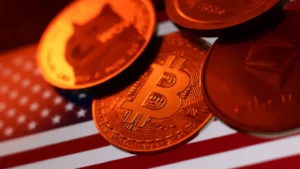High-Risk Crypto Lending Returns:
New Players Bet on Unsecured Digital Loans
A new wave of high-risk crypto lending ventures is emerging, fueled by rising investor confidence and renewed interest in digital assets. Just three years after the collapse of major crypto lenders during the 2022 market crash, companies like Divine Research and 3Jane are experimenting with uncollateralized loans, betting that blockchain and artificial intelligence will reshape microfinance.
Divine Research and the Microfinance Revolution
San Francisco-based Divine Research has already issued roughly 30,000 short-term, unsecured loans since December, partnering with Sam Altman’s iris-scanning crypto group, World, to identify borrowers.
“We’re loaning to average folks like high-school teachers, fruit vendors—anyone with internet access,” said Diego Estevez, Divine’s founder. “This is microfinance on steroids.”
Divine offers loans of less than $1,000 worth of Circle’s USDC stablecoin, mainly to cash-strapped overseas borrowers underserved by traditional banks. Borrowers are screened using Altman’s biometric system, which prevents defaulters from creating new accounts. Interest rates range from 20% to 30%, with default rates on initial loans averaging around 40%.
High yields on the platform are attracting individual depositors, with Estevez claiming the system is designed so that liquidity providers “always make a profit” despite defaults. This approach reflects the growing appetite for high-risk crypto lending strategies.
3Jane’s AI-Powered Lending Model
Crypto startup 3Jane is also pushing the boundaries by offering uncollateralized USDC credit lines on the Ethereum blockchain. The company recently secured $5.2 million in seed funding from Paradigm, a venture group that previously invested in FTX.
3Jane requires “verifiable proofs” of crypto, bank assets, or cash flow, but no actual collateral. Defaulted loans are sold to U.S. collections agencies. The company is developing AI-driven lending platforms where “programmatically bound” AI agents would follow debt covenants, allowing for lower interest rates.
Wildcat, Clearpool, and the Next Phase of Lending
Other protocols like Wildcat are targeting professional market makers and crypto trading firms with customizable credit facilities. Wildcat has facilitated approximately $170 million in loans to date, enabling borrowers to negotiate terms such as interest rates and maturity dates.
“In the event of a default, lenders coordinate directly among themselves to seek recourse,” said Evgeny Gaevoy, Wildcat adviser and CEO of crypto market maker Wintermute.
This shift signals a maturing landscape for high-risk crypto lending, even as regulatory scrutiny and market volatility persist.
Lessons from the 2022 Crash
The return of unsecured lending comes with significant cautionary tales. In 2022, the crypto market crash triggered defaults and bankruptcies at firms like Celsius and Genesis. Celsius CEO Alex Mashinsky was later sentenced to 12 years for fraud, while Genesis settled a $2 billion lawsuit with New York’s attorney general.
Despite these setbacks, major players like Coinbase, Tether, and Galaxy continue to dominate the crypto lending market, while Wall Street firms—including JPMorgan and Cantor Fitzgerald—are beginning to extend collateralized loans against cryptocurrency holdings.
The Road Ahead
With bitcoin trading near record highs and institutional interest returning, the high-risk crypto lending sector is poised for both growth and controversy. As AI-driven tools and blockchain protocols evolve, lenders are betting that this time will be different—but the risks remain as high as the rewards.

